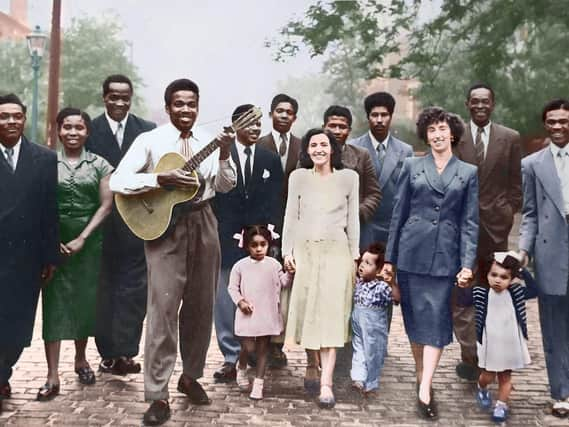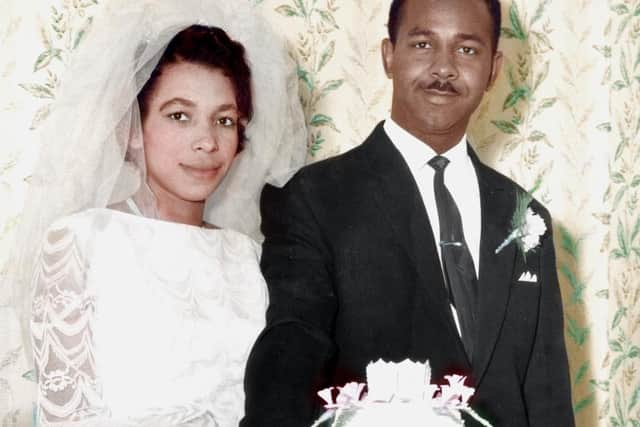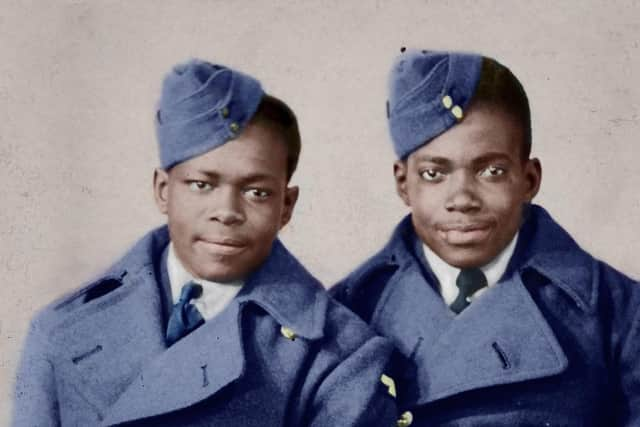The portraits that capture a new life for first generation Jamaicans who made Leeds their home


It’s the little details which place Hermerde and Enid Pitter’s wedding photograph firmly in the 1960s. There’s the backdrop of floral wallpaper which decorated the front room where their reception was held and there’s the china plates brought out only for special occasions. Mostly though it is the bowl of bright red – and noticeably untouched – glacé cherries which give the date away.
“I have looked at that picture my entire life,” says the couple’s daughter Susan Pitter. “The original was in black and white, but now it has been recoloured you suddenly start to notice all these little things which together tell a much more complete story of not just that day but of mum and dad’s life together in Leeds.”
Advertisement
Hide AdAdvertisement
Hide AdThe photograph is part of a collection which was first seen in an exhibition last year. Organised by Jamaican Society Leeds, the Eulogy project was designed to commemorate the lives of those who had made the journey to Yorkshire from the Caribbean island during the 1940s, 50s and 60s. Then they were shown in their original black and white prints, but now a selection of images has been recoloured for a follow-up project, appropriately entitled Back to Life.


“The idea was to create a lasting legacy from the Eulogy project,” says Susan. “When we spoke to those first generation Jamaicans about their first memories of arriving in Leeds, there were two recurring images – chimneys, lots of chimneys and the fact the city was so very grey compared to the island greenery they had left behind.
“Putting the colour back into these photographs was about giving the subjects back their warmth and personality and I also hope that it gives an important chapter in the history of Leeds the richness and depth it deserves.
“It really has brought to life unexpected details from patterns on outfits, to the architecture of Leeds buildings and together they capture the hopes and dreams in the eyes of a pioneering generation who arrived as young people ready to work, but who were also ready to fall in love and make friends.”
Advertisement
Hide AdAdvertisement
Hide Ad

Susan’s parents, who met while working on the buses in Leeds, had both grown up in St Elizabeth where money was tight and job prospects limited.
In Britain, as post-war austerity began to give way to economic optimism, the call went out across Jamaica and throughout the Commonwealth for those looking for new career opportunities, including work in the newly established NHS.
When they arrived, many settled in the Chapeltown area of Leeds, but the welcome they received was not always warm. In 1968, Enoch Powell made his infamous Rivers of Blood Speech criticising mass immigation and the National Front, which had been founded the previous year, was bringing racism to Britain’s streets.
Advertisement
Hide AdAdvertisement
Hide Ad“Those early years were tough,” says Homer Harriott, whose parents George and Veryl also feature in the exhibition. “The good jobs which had been promised often didn’t materialise, accommodation was often difficult to find and they often faced racism. They had to fight for their rights and when it came to that, both of my parents set a pretty high bar.”
Veryl was a formidable champion for young people, campaigned on behalf of the homeless and successfully influenced the formation of the 1968 Race Relations Act, which made it illegal to deny housing, employment or public services on the grounds of colour or race.
“When I was growing up I would often come home after a night out and find mum still up working on a case,” adds Homer. “She always put other people before herself; she couldn’t abide injustice. She died a couple of years ago and when we began clearing out her house we discovered folders full of copies of letters she had written and paperwork from the various campaigns she had worked on.”
Back to Life, a permanent online exhibition, has been made possible with funding from Arts Council England’s Covid-19 Emergency Response Fund which was set up to support cultural projects in the wake of the pandemic.
Advertisement
Hide AdAdvertisement
Hide AdIt includes images of Leeds’s first black female bus conductor, the city’s first black Justice of the Peace and a photograph of those who decided to launch their own church when existing congregations made them feel unwelcome. However, as much as it is a chronicle of the community’s history makers, it’s also a celebration of ordinary lives and the inclusion of passport photographs tell their own story.
Most had never left Jamaican shores before they embarked on the 5,000 mile crossing to Britain and many assumed that their stay in Yorkshire would be a relatively short one. However, as the years rolled by for those like Martha Agatha Armstrong memories of home became ever distant.
“She was a real matriarch,” says Derrick Armstrong of his grandma. “She would organise talent shows and teach us about Jamaican history and folklore – she was very determined that we shouldn’t forget our roots and believed that we shouldn’t forget the Jamaican culture.
“In many ways she was ahead of her time. She knew that we had to talk about the past and about slavery, but she also wanted to celebrate the positive aspects of our history.
Advertisement
Hide AdAdvertisement
Hide Ad“Now it’s relatively affordable to fly to the Caribbean but 40 years ago it was a different story. Many didn’t go back for years and some never visited the island again and it was people like my grandma who made sure that they still felt a connection with home.”
Most of the images which feature in the exhibition were donated by individual families. Many were taken by photographer Gerald Donne who had a studio in Chapeltown and who ended up being witness to a succession of marriages, christenings and anniversaries.
However, for Barbara Goodison, whose father Roy ‘Tommy’ Thomas died when she was just eight years old it is a photograph which originally appeared in the now defunct Yorkshire Evening News which provided an unexpected link to her past.
“I went to the Eulogy exhibition last year, turned the corner and saw my dad staring back,” she says, referring to the image of a group of friends heading to the cricket. “It was quite emotional when I saw it in colour for the first time and it also brought back some memories for my mother. She told me that she and dad would often have outfits made from the same material and now they are back united in their his and hers outfits.
Advertisement
Hide AdAdvertisement
Hide Ad“Before he died, he and mum had made plans to take the family back to Jamaica. His death meant that all our lives took a different path, but it’s lovely to have this picture of him looking so happy.
“Cricket is hugely important to the Jamaican community and for those like dad who had found themselves thousands of miles away from their family it was also a reminder of home.”
Back to Life is available to view online at www.jamaicasocietyleeds.co.uk